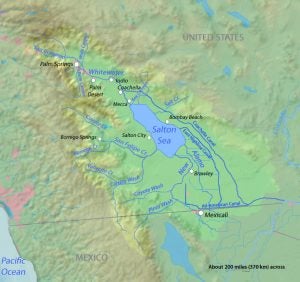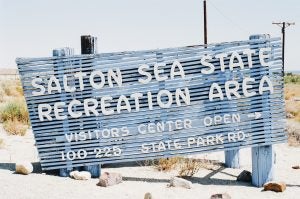We’ve seen it coming for years. The Salton Sea, California’s largest lake, has been in a slow and steady decline for decades. And things are likely to get worse at the end of the year.
That is, unless the state steps up and honors its commitment to manage and restore the sea.
A looming deadline
The Salton Sea was created in 1905 when floods breached a levee on the Colorado River, sending a wall of water through Imperial Valley and to the Salton Sink, a natural desert bowl roughly 230 feet below sea level. Water accumulated there and ultimately created the Salton Sea. For decades after that Colorado River water continued to sustain the sea as it passed through Imperial Valley farms as irrigation runoff.
That started to change in 2003 when the Imperial Irrigation District – which serves Imperial Valley farms – agreed to transfer increasing amounts of water to San Diego and Los Angeles. The agreement, referred to as the Quantification Settlement Agreement, is the largest agriculture-to-urban water transfer in U.S. history, with up to 303,000 acre-feet transferred annually. That’s enough water to supply over 600,000 households every year.
[Tweet “Teetering on the edge of disaster, what’s next for the Salton Sea? @PabloGarza9 explains.https://edf.org/XQS”]

The Salton Sea, California’s largest lake, is located in the southeastern Coachella Valley and northwestern Imperial Valley.
At the time the water deal was struck, Imperial Irrigation District and state officials knew the diversion would reduce flows to the Salton Sea, eventually causing it to shrink. The resulting impacts would be an environmental, economic and public health disaster. Critical fish and migratory bird habitat would be decimated, and the exposed lake bed would send thousands of tons of toxic dust into the air, exacerbating the region’s already impaired air quality and adversely impacting communities.
With that catastrophe in mind, Imperial Irrigation District agreed to replenish the Salton Sea by sending additional water directly to it. This “mitigation water” would be provided for the next 15 years until the end of 2017, allowing state officials more than enough time to develop, fund and start implementing a restoration plan for the lake.
But progress has been slow, and with the end of 2017 just weeks away, communities in the Imperial Valley are once again thinking about the disastrous outcomes of a shrinking Salton Sea.
A reason for hope
Luckily, in recent months, state officials, along with local residents and environmental groups, including Environmental Defense Fund, have been working in earnest on solutions.
In November, the State Water Resource Control Board approved a 10-year plan for the lake that Governor Jerry Brown’s administration released in March. The $383 million plan commits the state to build thousands of acres of ponds and wetlands to serve as dust control and to create habitat for fish and birds.
The Salton Sea has been chronically underfunded, but state legislators took another positive step in September with the passage of SB 5, a $4 billion parks and water bond which the state legislature approved and Governor Brown signed, qualifying it for the ballot in 2018.
If approved by voters, SB 5 will allocate $200 million to the Salton Sea and implementing the State’s 10-year plan.
So the pieces are starting to fall into place. For the first time in 15 years, we have some momentum. But much more progress is still needed. 2018 is right around the corner. Let’s get some projects on the ground.
Related:
California’s upcoming water bond measure will do more than meets the eye >>
What it’s going to take to fund California’s water infrastructure >>
What the Oroville Dam crisis tells us about natural infrastructure >>











6 Comments
I live a few miles from the Salton sea. I see it from ny windowa and smell the stench of decay. It just brakes my heart. Please save it.
This almost looks good on paper…it’s only another smoke screen. I live in Bombay Beach on the Salton Sea. I’ve been here 5 years. Nothing has happened to improve this place. Nothing at all. IF the state does get the money talked about in this article I have no doubt that it will find ways of readjusting the different budgets set throughout the state for different departments to absorb what is suppose to be allocated for the Salton Sea. It is already a major dust bowl. I can clean my counter tops and within an hour there is enough dust to write my name in it! I find these articles that periodically pop up soo annoying. I don’t even begin to get my hopes up. So NOW it depends on the out come of the next vote. What happened to the agreement that was suppose to be meet over the last 15 years. Nothing happened to it. If that agreement is considered to have been met…it’s a lie. This talk literally makes me sick.
P.S. In the 5 years I’ve lived in Bombay Beach, I’ve seen the shoreline recede the length of 2 football fields. How much longer are they going to wait?
Why not pump ocean water into it with a temporary pipeline.? Theoretically, once the water was over the mountains it would siphon in.
The State of California is unintentionaly warming the Imperial Valley desert causing higher air pressures and stronger late season winds in San Diego and the LA/OC basin, exacerbating wildfire conditions.
The Salton Sea is being drained and has shrunk in surface area by 10% (36 sq. miles). The Salton Sea previously evaporated 1.3 million acre feet of water per year cooling the imperial valley. The State has not kept it’s agreements to mitigate and restore the Sea.
The State could import Sea of Cortez water downhill through gravity fed canals to solve the problem but has drug it’s feet for more than a decade. The problem will only get worse as the Quantification Settlement Agreement increases water transfers starting January 2018.
Let it die! It was man made to begin with. Let it go back to it’s natural state!